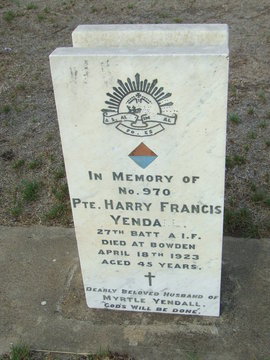
23920
YENDALL, Harry Francis
| Service Number: | 970 |
|---|---|
| Enlisted: | Not yet discovered |
| Last Rank: | Private |
| Last Unit: | 27th Infantry Battalion |
| Born: | Hindmarsh, South Australia, Australia, date not yet discovered |
| Home Town: | Hindmarsh, Charles Sturt, South Australia |
| Schooling: | Not yet discovered |
| Occupation: | MINER |
| Died: | 18 April 1923, cause of death not yet discovered, place of death not yet discovered, age not yet discovered |
| Cemetery: |
West Terrace Cemetery (AIF Section) AIF Cemetery (Path 5, Grave 3 East), West Terrace, Adelaide, South Australia: 3 |
| Memorials: |
World War 1 Service
| 31 May 1915: | Involvement Private, 970, 27th Infantry Battalion, --- :embarkation_roll: roll_number: '15' embarkation_place: Adelaide embarkation_ship: HMAT Geelong embarkation_ship_number: A2 public_note: '' | |
|---|---|---|
| 31 May 1915: | Embarked Private, 970, 27th Infantry Battalion, HMAT Geelong, Adelaide | |
| Date unknown: | Wounded 970, 27th Infantry Battalion |
Help us honour Harry Francis Yendall's service by contributing information, stories, and images so that they can be preserved for future generations.
Add my storyBiography contributed by St Ignatius' College
Harry Francis Yendall was born in late December 1880 to William and Mary Ann Yendall in Hindmarsh, South Australia. In July 1909 Yendall married Annie but his sister Julia was nominated as his next of kin when he enlisted.
Yendall enlisted for the Australia Imperial Force (AIF) on the 24th of February 1915 and was placed in the 27th Battalion. The 27th Battalion was a battalion mainly based in South Australia. The 27th Battalion saw action on the Western Front during World War I. Some battles that Yendall’s battalion was recorded to fight in was Fromelles (1916), Pozieres (1916), Bullecourt (1917), Messines (1917), Passchendaele (1917), Villers-Bretonneux (1918), Hamel (1918), Amiens (1918), Mont St. Quentin (1918), and the Hindenburg Line (1918). The 27th battalion participated in multiple training sessions so then all the soldiers were fit and able to fight. Starting training was done in South Australia but for the most part training went on in July 1915 Egypt. Whilst training in Egypt Yendall had gotten Pneumonia in late 1915 .
Yendall didn't behave well throughout his time in the military. Yendall was suspended from the AIF because of multiple reasons. These reasons consisted of using foul language to his commanding officers and his fellow soldiers, taking leave without approval and being intoxicated. Some examples of this was when he went AWL from the 8th of February to the 12th of February. His punishment for this was 15 days with no pay. This was a regular act and caused him to spend multiple weeks away from the fighting. While he was fighting on the army his roll was infantry. Infantry soldiers are soldiers who would fight on foot and defend their sides territory. Yendall wasn’t an infantry soldier for the whole war, he also spent some time working in the Australian Veterinary Hospital. It’s been recorded that he was a vet on the 31st of July 1917. Vets in the war would take care of the horses if they have been damaged or wounded. Yendall’s time in the war awarded him with the 1914-15 Star, the British War Medal, and the Victory Medal, esteemed decorations recognizing his service and sacrifice during World War I.
On the 26th of July 1918 Yendall was honourably discharged from the AIF due to having bronchitis. When Yendall was 45 he sadly passed away on the 18th of April 1923. His grave is located at AIF Cemetery (Path 5, Grave 3 East), West Terrace, Adelaide, South Australia.









